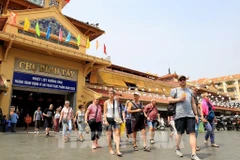Thanh Hoa (VNA) – Located just 3 kilometres from the centre of Thanh Hoa City, Dong Son village in the north-central province of Thanh Hoa is renowned for its connection to the famous Dong Son ancient culture.
This village, which has existed for thousands of years, and has preserved its cultural heritage despite the challenges of war and time.
Recognised as one of the ten most beautiful ancient villages in Vietnam, Dong Son captivates visitors with its rustic charm and tranquil atmosphere. The village exudes a sense of simplicity, embodying the essence of rural life in Vietnam.
Visitors to the village experience a peaceful environment, engage with elderly locals, and enjoy a glimpse into life as it was centuries ago. The serene landscape, adorned with lotus ponds and fragrant frangipani flowers, makes this ancient village a delightful retreat amidst the hustle and bustle of the city.
One of the village's unique features is its dedication to preserving its traditional architecture and cultural values. The brick and stone walls, along with the stone pathways, reflect the rich architectural heritage of the area. Covering nearly 4 sq.m, the village is home to approximately 330 households and over 1,000 residents.
A distinctive aspect of Dong Son village is its system of alleys named Nhan, Nghia, Tri, and Dzung. The names represent essential values that local community respects most.
“Nhan” symbolises compassion and mutual assistance. Residents here emphasise community bonds, always ready to help one another.
“Nghia” embodies loyalty and gratitude, highlighting the importance of traditional values and a sincere way of life.
“Tri” stands for knowledge and learning, reflecting the villagers' respect for education and intellectual achievements.
“Dzung” represents courage and resilience, showcasing the strength and determination of the villagers to overcome challenges.
Walking through these alleys immerses visitors in the rich historical and cultural tapestry of Dong Son, illustrating the community’s ethical values and fostering a sense of connection and love.
Valuable historical cultural heritage
Dong Son ancient village attracts tourists not only for its picturesque scenery but also as a custodian of valuable historical and cultural relics. Notably, the wooden house of Luong Trong Due, built over 200 years ago, showcases typical 19th-century architecture. Recognising its significance, Due’s son Luong The Tap, has diligently restored and preserved this heritage.
He also set up various spaces displaying traditional farming tools and decorative artifacts, illustrating the essence of rural life in Thanh Hoa.

Other historical sites in the village include the temple dedicated to Trinh The Loi, a revered figure in the village's founding. Situated on the highest hill, this temple serves as a crucial worship site for the local community.
At the village's end lies the Pham Thong pagoda, which once housed a bronze statue of Buddha and a large, airy cave known as Tien Son. The village also boasts a well over 2,000 years old, that attracts a host of visitors. The well symbolises the village's enduring legacy.
The village is adorned with a rich collection of cultural religious sites. There is a temple, recognised as a national heritage site, dedicated to Saint Le Uy, and Tran Khat Chan, a prominent general of the Tran Dynasty. These structures not only represent historical assets but also reflect the cultural exchanges that have occurred over the centuries.
Throughout its history, Dong Son has mirrored the fluctuations of Thanh Hoa's development. Artifacts like agricultural tools, weapons, ceramics, and unique jewelry unearthed in the village mark significant periods in Vietnamese history, showcasing the continuous evolution and creativity of its people.
The village is not just a historical tourist destination. It is also a precious piece of the cultural heritage of the nation. It stands as a testament to the development of the Dong Son culture, one of Vietnam's vital prehistoric cultures./.




























